Table of Contents
American Flagfish Care
The American Flagfish is an easy-to-care-for fish with a peaceful temperament. It requires a tank size of at least 10-20 gallons and a temperature of 64-72 degrees Fahrenheit. They eat algae, insects, and crustaceans.
American Flagfish Overview
How often do you look around different colorful fish species to add to your tank? Happens more than we’d like to admit. That said, the American flagfish is one of the few unique-looking fish species that closely mimic the appearance of an American flag, hence the name.
These small fishes are natives of Florida and are often found in muddy and vegetated waters where they derive most of their nutrition.
American flagfish has metallic tinges and bright red, blue, or yellow streaks that pop out against the greens of the leaves, the browns of the bog woods, and the dark/light substrate. As the viewer stares in awe of the scenery, an unsung hero zips around the tank, keeping nuisance algae from taking over.
If you are considering adding some burst of colors to your home aquarium, an American flagfish is hands down one of the best additions. This guide will discuss all that you need to know about their care and their feeding and breeding requirements.
| Information Chart | American Flagfish |
| Scientific Name | Jodanella floridae |
| Family | Cyprinodontidae |
| Care level | Easy |
| Temperament | Peaceful |
| Color | Red stripes with luminescent green |
| Lifespan | 2-3 years |
| Size | Up to 2.5 inches |
| Diet | Omnivore |
| Minimum tank size | 10-20 gallons |
| Temperature | 64-72 degrees Fahrenheit |
| Water conditions | Freshwater with slow current |
| Tank mate compatibility | Peaceful |
American Flagfish Appearance

Despite what many might say, American Flagfish is exceptionally hardy, adaptable, and can easily mold itself to the environment. Moreover, they are undemanding fish, meaning that a few fish can live in a tight space without becoming territorial.
The fish does grow up to a maximum size of 2 inches in captivity, which is a lot smaller than you’d anticipate. They do grow a bit longer in their natural habitat. They get their name due to the speckled appearance of the blue, red, and white on their body that mimics the appearance of an American flag.
Apart from being a voracious algae eater, it also has a remarkable color pattern that features bright red stripes and a luminescent green that stretches across its entire body. Its iridescence reveals flashes of stars, reminiscent of the Star-Spangled Banner.
Ensuring they have enough space to move around is essential for their safety and comfort in the home tank. Many aquarists even remark that their body resembles that of a bulldog, which is unique.
The male fishes are a lot more colorful and vibrant compared to the female ones. However, these are algae eaters, including the black beard algae, which is why they are often found in abundance in outdoor ponds.
Lifespan of American Flagfish
The typical lifespan of an American flagfish is between 2-3 years. However, if well taken care of, they can also live up to 5 years, which is extremely rare.
American Flagfish Size
The typical American flagfish grows up to 2 to 2.5 inches in captivity. This is around 5 to 5.5 cms. However, there are a few exceptions, especially in the wild, where they grow a few inches longer.
Natural Habitat and Origin
As mentioned in the beginning, the American flagfish is native to Florida and originates in the Yucatan Peninsula. They are mostly found in vegetated water with murky and muddy water appearance, especially in slow-moving marshes or ponds.
Scientifically termed as Jodanella floridae, the fish species was first discovered in 1879, which is quite a long time ago.
Besides being a unique algae eater and being found in water conditions with a lot of vegetation around, these freshwater fishes are also adaptive. They can easily mix with other fish species, especially the ones that are their size. They pair well with tropical fishes.
As for their living conditions, American flagfish do have a habit of staying on the topmost layer of the tank; however, you will also find them lurking around the middle and rarely at the bottom of the tank, depending on their mood and movement.
They are jumpy fishes, meaning that they will try to jump out of the tank on the topmost layer. So, make sure that you always keep the aquarium lid closed if you don’t want to give them a painful death.
American Flagfish Care and Tank Set up
The American flagfish is a Killifish that is well-known for being a voracious algae eater. This fish is an aquatic lawnmower on steroids and will happily help rid you of any algal blooms in your tank.
The American flagfish is native to Florida and can mostly be found in lakes, swamps, and other slow-moving or still bodies of water. It can adapt to a wide range of water conditions and be mixed with different kinds of fish from the tropical side with mollies and platys to the cooler side with white cloud mountain minnows.
However, knowing about their care and tank setup is essential if you want them to give the best life possible.
American Flagfish Tank Size and Specifications
The American flagfish will thrive in an aquarium with driftwood, rocks, plants, and other elements that could make an aquarium feel more natural. As with a lot of smaller fish, the American flagfish will be more confident swimming in the open if it sees many hiding places that it could bolt to in times of trouble. It also appreciates the wide-open spaces of lakes and swamps, so it’s a good idea not to overstock the aquarium with decor. Here are the nitty-gritty details:
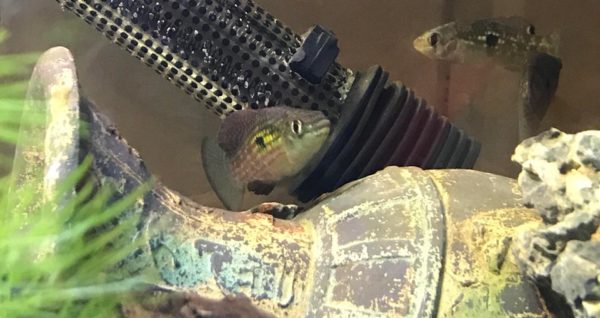
Optimum Tank Size for American Flagfish
The recommended tank size for American flagfish starts from 10-gallons. This is ideal if you are keeping just one of the fish. However, they stay happier and more confident when they are kept with their kind or in a community tank.
So, if you had to ask the minimum tank requirements, we’d suggest stick to a 20-gallon tank instead. Keeping 5-6 of these fishes is ideally considered the best option.
Filter
The small size and their natural habitat push aquarists to keep them in a minimal water current setup. So, if you have a home tank with fish that require a faster stream of water current, they won’t do well in those kinds of community tanks.
Sponge filters are a pretty good addition and can provide them with comfortable living conditions without any challenges. They also don’t generate much waste, so they don’t need a potent filter in the tank.
Substrate
Compared to the original color scheme of the fish, you want to fill up the tank with the dark-colored substrate as a contrast. Since they aren’t bottom feeders and rarely navigate to the bottom of the tank, you can go ahead and fill the bottom with some sand and gravel-based substrate for a comfortable setup for these freshwater fishes.
In this case, you may want to go with dark brown to still emphasize the brightness and luminescence of the American flagfish, without muting the colors of darker tank mates.
Besides the standard substrate, you can add other nitty gritties like driftwood and plants to make up for hiding spots in the tank.
How many American Flagfish in 20-gallon tank?
If we had to suggest the optimal number of American flagfish in a tank, we’d recommend that you keep 5-6 of them in the 20-gallon tank to keep them occupied and happy.
Water Parameters for American Flagfish
Although the American flag fish are considered hardy fishes, any mismatch to the water parameters will affect their lifespan.
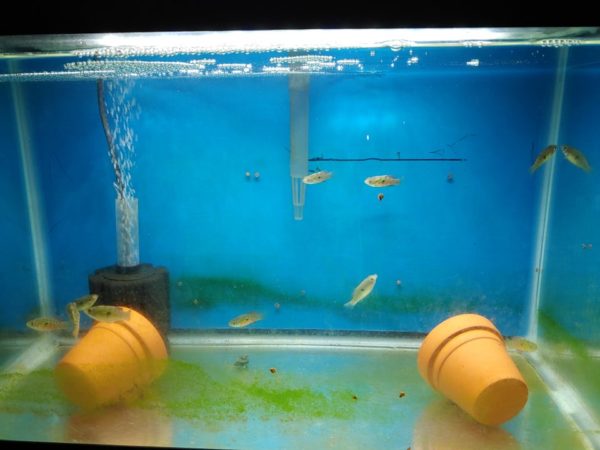
From the temperature to the pH, you need to be mindful of every minute detail, primarily when you are housing them in a community tank. Ideally, the American flagfish is suitable for beginners as they aren’t demanding fishes and often keep to themselves. However, for your convenience, we have sorted out some important pointers that you need to be mindful of:
Water Temperature
The ideal water temperature for American Flagfish is between 64-72 degrees Fahrenheit, which means that they like their water cooler than some of the other standard freshwater fishes.
pH Level
The perfect water pH level for American Flagfish is 6.2 to 8.2. This means that they can live in slightly acidic to slightly alkaline water conditions.
Water Hardness
The water hardness in the tank should be between 6-20 dGH.
American Flagfish Tank Landscape
American flagfish aren’t territorial and often like to stay in groups in the tank. However, that doesn’t mean you’d need to overfill the tank with decorative pieces and setup. Instead, keeping the tank clean should be your main priority besides the tank landscape.
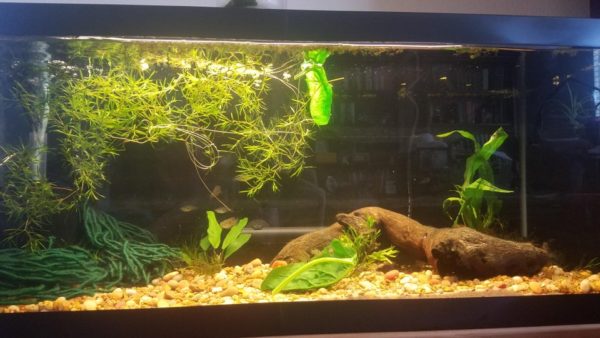
We have sorted out some important pointers in this section for you:
Best Plants for American Flagfish Tank
A dark blue background helps create the illusion of having more space behind the tank. Lastly, an aquarium LED light will significantly enhance the look of any planted tank by creating a “shimmer effect,” wherein the multiple rays of light from the LEDs dance with the movement of the water from the filters or aerators.
Since the American flagfish is surrounded by vegetated water in the natural habitat, it isn’t surprising that you should fill the tank with plants like java moss after quarantining them for a few days. Also, when placing the plants inside the tank, you need to ensure that you strategically place them, so the fishes have enough space around the tank for swimming.
Also, stack up plants inside the tank that can grow in cold water conditions. Moreover, make sure that the tank gets direct sunlight exposure from time to time to enable algae growth. Emulate these fishes’ natural habitat, and you won’t have to worry about their health and well-being.
Decorations for American Flagfish Tank
The American flagfish don’t require many artificial elements in the tank as part of their decorations. However, make sure that you add natural décor pieces like rocks and driftwood to keep them occupied in the tank.
If you want other decorative pieces to spruce up the tank’s look, adding a few plastic houses and caves make up for a good addition. However, always make sure you quarantine these pieces before adding them to the tank.
Lighting for American Flagfish Tank
Although these small freshwater fishes need sunlight exposure in the tank time and time, they don’t enjoy directly exposed lighting.
Your ideal choice would be to add LED lights as they provide minimal glow and a beautiful look to the tank landscape. However, the fishes do like the shade now and then, so make sure you add plants to compensate for the same.
Feeding American Flagfish
The American flagfish is a voracious eater, so it’ll eat almost anything it finds in your tank, from the nasty hair algae growing on your rocks and glass, to the insects unfortunate enough to fall, to wilting leaves soft enough for it to nibble on. They’re used to munching on a lot of algae, so if your tank isn’t too terribly overrun by algae, you may want to supplement with algae wafers.
They are typically omnivores in their natural habitat and rely on different foods, including algae, insects, and crustaceans. So, when housing them in captivity, you need to recreate that diet for them as closely as possible.
As a beginner, you can start with flake foods that are developed specifically for their diet. Since they are top dwellers, flaky food is better than pellets that sink to the bottom. Besides the store-bought food, even a few pieces of vegetables are an excellent addition to their diet.
Since they tend to overeat, you will also find them gobbling down frozen foods that you give them as a treat. Some of the different kinds of live food that they rely on are:
- Daphnia
- Brine shrimp
- Bloodworms
You can also replace the live foods with their frozen version if there are accessibility issues. However, one thing about their feeding that you need to be mindful of is the vegetables. If there isn’t any optimal algae growth in the tank, you need to supplement those nutrients with veggies and greens.
Some of the ideal vegetables for American flagfish include:
- Peas
- Zucchini
- Cucumber
Alongside vegetables, you can supplement them with different kinds of algae-based food to meet their daily requirements.
American Flagfish Behavior and Temperament
The American killifish or flagfish have a peaceful nature and make for a fantastic addition to community tanks. However, they don’t pair well with every freshwater fish, especially when introducing the male ones.
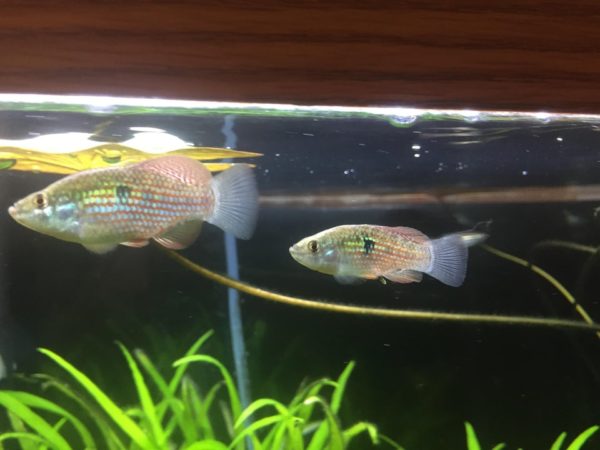
The male ones can sometimes show signs of aggression if they become territorial. So, make sure that you don’t add more than two male flag fish in the tank and place them away from each other, so they have their own space to swim around.
Also, these fishes are pretty active and will zoom around the tank throughout the day. So, you want to pair them with equally active fish, so they have an excellent time shoaling
American Flagfish Tank Mates
American flagfish are relatively easy to keep and will survive even with the clumsiest beginners. A paired couple will live happily in a 10 gallon planted tank, but it might be a bit too much for more peaceful fish. If you plan to keep other shier and more slow-moving fish, you’ll want to upgrade to at least a 20-gallon tank. If you can get a bigger tank, you’ll be able to keep them in a group of 6 or more, which can brighten up a community tank and help nuke the tank’s population of algae.
For community tanks, the American flagfish have somewhat mixed results; they can get too energetic, to the point of nipping the fins of slower fish like guppies or betta fish. You’ll want to keep them with fish that can keep up with their speed – perhaps a school of danios or tetra will do. If you wish to keep them with other more placid or slow-moving fish, you can work out an aquascape that breaks the line-of-sight of the flagfish so that the other fish can have time to rest recharge.
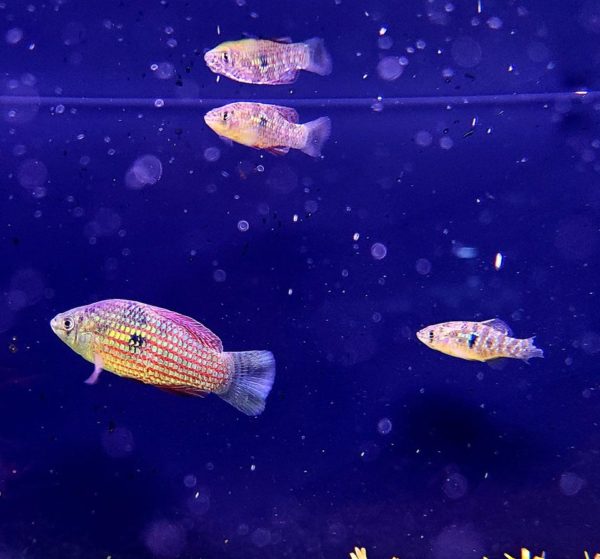
Speaking in terms of color alone, glowlight or neon tetra might be your best bet. If you prefer to fish with excellent schooling behavior, then you can go with rummy nose tetras, as they tend to stick together more often than most schooling fish. As a bonus, their redness can be used as a barometer for tank conditions; the redder they are, the better the tank condition is.
Breeding American Flagfish
If you have the ideal aquarium setting, the aquarium flagfish will breed in natural conditions without any complications. However, we’d not recommend letting the breeding happen in a community tank because it puts the newly hatched fry at risk of being eaten by the other fishes.
Ideal Breeding Tank
To set up the American flagfish’s ideal breeding conditions, you need to set aside and transfer the male and female fishes into a separate breeding tank. The tank should ideally be between 20-24 inches in length and contain shallow water levels.
Also, like the standard tanks for the mature ones, even the breeding tank should have a slow water current with the sponge filters. As for the temperature, keep it stabilized at 72 degrees Fahrenheit for the optimal settings.
In short words, you want to create the same water parameters and setup as you would with the mature flag fish, so they have a comfortable breeding experience.
Breeding Behavior
Once you have transferred the male and the female flagfish into the breeding tank with ideal settings, it is a matter of waiting from there. The sexually mature fishes will soon start the mating dance.
If you are having a hard time distinguishing the male from the female ones, note that the male fish has a brighter color on their body. The female ones have a yellow appearance.
Once the female flagfish lays the eggs on the plants or substrate, they immediately fertilize the eggs and then protect them. Ensure that you remove the female fish once it’s done laying eggs because they don’t have any parental instinct and will try to eat the fertilized eggs.
On the other hand, the male flagfish is highly protective of the eggs and fan them with its dorsal fin till they hatch. Once the eggs hatch, remove the male flagfish and wait till the fry matures. The eggs will take up to 10 days to incubate and then hatch, so you need to be patient with the process.
American Flagfish Disease and Treatment
The Florida flagfish is quite hardy and doesn’t contract the common tank diseases that several other freshwater fishes struggle with. However, they do tend to contract bacterial or parasitic infections.
If you find white lumps under their skin, it is a sign of infection. Make sure you remove the infected fish from the tank immediately to prevent further spread. Also, clean the tank now and then, at least once every two weeks, to reduce the risks of such infections in the fish.
Are American Flagfish Right for You?
If you are a beginner aquarist who wants to test out waters with different freshwater fishes, the American flag fish is an excellent option to look out for. They are easy to maintain, don’t involve a lot of expenses, and aren’t demanding.
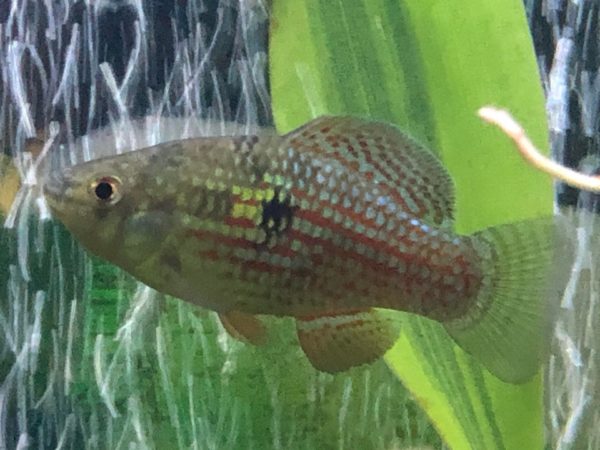
However, the best part about these small fish species from Florida is their sparkly and vibrant appearance that stands out in any tank that you put them in. So, if you want to spruce up the look of your tank, getting an American flagfish is a good choice.
FAQs
Are American Flagfish livebearers?
No, the American flagfish aren’t livebearers. They are oviparous, meaning that they lay eggs, then incubate and hatch within ten days.
Will Flagfish eat shrimp?
Yes, American flagfishes aren’t picky when it comes to their food. They are omnivorous and can eat anything, including brined, live, or frozen shrimp.
Do American flagfish eat plants?
Although the American flagfish don’t necessarily feed on the aquatic plants, they feed off different kinds of algae. Besides that, they also eat a spread of vegetables, including peas, cucumber, and zucchini.
Conclusion
The American flagfish is a gem that not a lot of aquarists know about. For some, it might be a handful because of its quirky personality and insatiable appetite for greens. Still, if you’re looking to add a majestic splash of color in a tank that’s perhaps overgrown with algae, then the American flagfish might just be the next centerpiece you’re looking for.
We hope this care guide gives you all the necessary information that you are looking for. If you have any doubts or queries, make sure you leave them in the comments, and we’ll get back to you.
